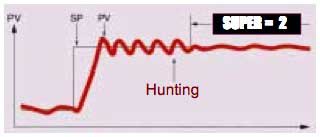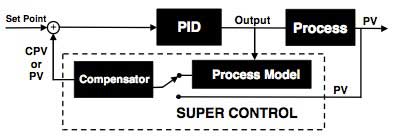Overview
 |
| Load Change |
Yokogawa first introduced its renowned SUPER CONTROL™ in industrial controllers over a decade ago. This is a fuzzy logic alogrithm that eliminates overshoot from the desired set point and mimics the control expertise of the most experienced operator. Recently, the development engineers at Yokogawa released two additional SUPER CONTROL™ functions in the Enhanced GREEN series industrial controllers that provide even better control.
In a furnace control application, as the load changes or a set point change is made, the temperature may tend to become unstable and oscillate around set point. The traditional way to prevent this action was to install different sets of PID tuning parameters. The new SUPER CONTROL™ modes eliminate the control instability. Refer to the graphics below.
Auto Tune
 |
| Temperature Change |
Yokogawa has embedded an auto tune function in industrial controllers for years. After the auto tune function is initialized, the control output is alternately varied from 0% to 100%. The controller observes the response of the process input and provides the optimum PID tuning parameters at a single set point within the input range. Additionally, up to 8 different PID sets can be auto tuned within different zones of the input range.
Auto tune sometimes cannot be applied during operation due to a possible process upset. The two new SUPER CONTROL™ functions may be applied to provide optimum control even when auto tune cannot be used.
SUPER 2 & SUPER 3
How does it work?
 |
| SUPER CONTROL = 2 or 3 Output |
Control instability occurs when the closed loop gain is greater than 1.0 or the deviation between the process variable and control output become 180° out of phase. The SUPER 2 or 3 functions observe any phase shift. If the input phase has changed from normal operating conditions, SUPER 2 or 3 computes a calculated PV (CPV) using a process model and suppresses hunting. The process model simulates the PV without any inherent dead time.
It is simply the first order lag time with gain. A compensation model switches between the measured process variable (PV) and the calculated process variable (CPV) as needed to prevent PV hunting. The control function block performs normal PID computation. Refer to the functional block diagram below.
What is the difference between Super Control™ modes?
If SUPER CONTROL™ Mode 1 is selected, overshoot suppression is initialized. As the PV approaches a new target set point, the SUPER CONTROL™ observes the rate of change and installs "sub-set points" as the PV approaches set point to insure overshoot does not occur.
If SUPER Mode 2 is selected, this insures high stability at set point while sacrificing some response time to a set point change. The gain and lag time calculations differ from that in Mode 3.
If SUPER Mode 3 is used, response speed to a set point or load change is faster than Mode 2 with some sacrifice in stability as a new set point is entered and the process variable approaches that change.
SUPER CONTROL™ is another innovation by Yokogawa to provide the best possible PID control action in industrial applications.
Industries
-
Drilling
Onshore unconventional drilling is commonly used in the extraction of oil and natural gas today. There are an increasing number of multi-well pad type drilling programs in most of the active plays. Different drilling technics are used to decrease drilling time, lower environmental impact and to improve initial and estimated ultimate recovery.
-
Floating Production Storage & Offloading (FPSO)
- Floating Production, Storage, and Offloading (FPSO) unit
- Offshore production facility
- Stores processing equipment, produced hydrocarbons storage
- Feasible to produce oil in remote areas, deeper water
-
Onshore
The onshore upstream industry faces ever higher demands and greater challenges with increasingly difficult and hostile environments in which it must operate.
-
Processing & Fractionation
- Natural-gas processing
- Control dew point of natural gas stream
- Separate natural gas liquids for sale and distribution
-
Topsides
- Topsides processing and handling on the production platform prep extracted hydrocarbons for transport
- Yokogawa integrated control/monitoring maximize topsides operations productivity and availability
-
Wellhead & Separation
The wellhead provides the structural and pressure-containing interface for the drilling and production equipment. The surface pressure control is provided by a christmas tree, which is installed on top of the wellhead. Isolation valves and choke equipment physically control the flow of well fluids when the well goes into production. Various automation packages are added to locally or remotely monitor, control and optimize production from each well or multi-well pad. Oilfield separators employ a pressure vessel to separate well fluids produced from oil and gas wells into gaseous and liquid components which are then transferred to pipelines or localized storage depending on the areas infrastructure.
Have Questions?
Contact a Yokogawa Expert to learn how we can help you solve your challenges.